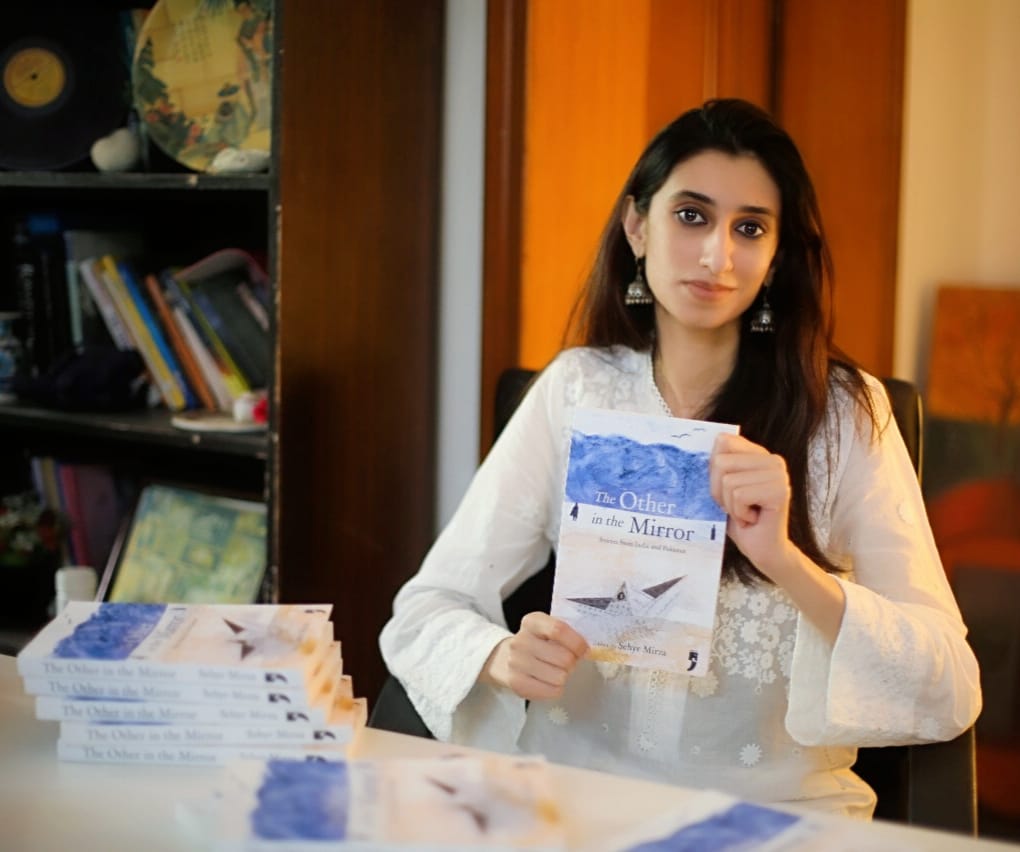Edited by Sehyr Mirza, a new anthology of short stories, The Other in the Mirror, features a story by noted lyricist and filmmaker Gulzar among others.
By Sheharyar Rizwan
The Indian subcontinent may have divided into Pakistan and India over 75 years ago, but the large-scale trauma, pain, bloodshed and displacement lingers on in the minds of those who experienced the events surrounding the Partition. These people still yearn for their homes they had to leave in an instant to save their lives and migrate to the other side of the border. They still recall their loved ones they lost in front of their eyes during the carnage and grew up with those images imprinted on their minds forever. A handful of Partition survivors did get a chance to visit their birthplaces decades later at the fag end of their lives.
Besides personal losses that people on both sides of the border suffered, the events of August 1947 have also turned the ‘other’ across the border into an exotic character – so close, yet so far and inaccessible, thanks to strict visa regime between the two countries making it almost impossible for these peoples to meet.
While on one hand the horrors of Partition maybe impossible to erase from memories, those who migrated to the other side are often seen reminiscing about the good, peaceful life they enjoyed in their hometowns – the nostalgia of pluralism and coexistence among Muslims, Hindus and Sikhs unlike what they experienced later. And it is these almost fantastical stories she heard from her grandmother that convinced Lahore-based journalist and author Sehyr Mirza to compile and publish an anthology of short stories by writers from both India and Pakistan, including one from the iconic Gulzar, capturing the impacts of Partition 75 years on.
Sehyr started working on the book ‘The Other in the Mirror’ during the Covid-induced lockdown in 2020 and got in touch with writers from both sides. She had grown up listening to stories about life on the other side from her grandmother, who belonged to Kota, Rajasthan and had to migrate at the age of 15 or 16. Almost all the stories were about pluralism and coexistence there.
“I was fascinated by the other side through her stories; it was nostalgia. She wanted to visit her hometown, but never could. But when I was able to visit India in 2013 and later a couple of other times, I spoke to people, conducted interviews and found that the hate narrative, the stereotypes about people across the border, the negative perception, all exist equally on both sides. It’s like a mirror of the other side, hence the title of the book,” she told Kashmir Newsline.
Sehyr feels, despite a litany of literature available on Partition, stories about its ongoing impacts are missing – the miseries of the fishermen, climate issues caused by nuclear tests, warmongering following bureaucratic statements by leaders among many others.
“These fictional stories are all inspired by real-life sentiments and incidents we see and hear almost on a daily basis. There’s a dystopian story set 30 years from now after a nuclear war, another about languages linked with religions, diasporic stories like an Indian and a Pakistani meeting in Europe and connecting through ghazals of Mehdi Hassan,” she says.
Sehyr echoes the common observation that when people from the two countries meet in another land, they end up discussing nostalgic tales about the common art, heritage, culture, shared history and the relatability between the two sides. She herself has contributed a story to the anthology – about villages on either side of the border haunted by supernatural beings and both blame each other that it’s a Hindu or a Muslim ghost.
“The reactions to situations are so similar on both sides that I wanted to collect stories that talk about pluralism, co-existence, connecting both the countries and bridging the gap,” says Sehyr.
The book opens with noted lyricist and filmmaker Gulzar’s widely popular story, Raavi Paar, about a Sikh family migrating from their native Lyallpur (now Faisalabad on the Pakistani side) to India in 1947 and the tragedy that befalls them near River Ravi. On how she decided to make Gulzar a part of the book and how easy or difficult it was to get through to the veteran, the young journalist said Gulzar was always on her mind when she started working on the book, as she had interviewed him back in 2013 during her first visit to India. “He truly is an ideal, a symbol of peace and harmony between India and Pakistan and a lot of people look up to him. I reached out to him this year in March, explained the rationale of the project, and he agreed. I wanted to start the book with it because it presents a background of Partition and then the remaining stories present the lasting impacts till the present day,” explains Sehyr.
It took her two years to compile and put the book together. She had to get in touch with writers who actually believed in these ideas and had worked on these topics. The response was welcoming and the writers took about five months to submit their stories. But Sehyr was clear she wanted the writers who were genuine, well-deserving and ones who don’t usually make it to the festival circuits owing to lobbyism. She also wanted to select those that had written in English, Urdu or Hindi. But the search wasn’t one without challenges.
“A lot of people were sending in Veer Zara-inspired love stories, which we wanted to exclude because I wanted larger discussions around the impact of Partition. We have already seen a lot of love stories in Bollywood; they don’t trigger discussions on neglected issues. There’s one story about soldiers posted on the border who, owing to mistrust, end up killing a mother dog. So that sheds light on how we impact nature because of our fears and apprehensions. Then some submissions we excluded were those directly targeting the state or being too political,” she recounts.
That’s not all. Once the book was ready and published in India (and coming to Pakistan any time now), Sehyr and filmmaker Ammar Aziz designed a project around it called ‘Kahani Project’, under their NGO Samaaj, animating stories from the book into short films. The first film to be released is based on Gulzar’s story.
Ammar handles the animation part. He told Kashmir Newsline that they chose to animate the stories that were more India-Pakistan centric and helped initiate a conversation about the countries.
“The technique used is traditional hand-drawn animation, where drawings are made frame by frame. Most of the work is done here, but we have engaged Indian artists also, which also makes it the first of its kind collaboration between visual artists,” said Ammar.
To ensure the first animated short film released reaches global screens, the team is formulating a distribution strategy to take the film to festivals before being widely available for the public online.
“When the project evolved, we realized not everyone can access the book, so we wanted to reach those also who couldn’t get their hands on the book to get the message across to them too. It’s a visual medium and you don’t need language or any expertise to understand it; it hardly has dialogues,” he said.
Another purpose of the Kahani Project was to organize storytelling sessions in both the countries to convey the narrative and at least start conversations around neglected topics, and to counter hate. A session has already been held in Lahore so far with youths reading selective stories. On the Indian side, however, multiple events have been held in Chandigarh, Pune and Mumbai and many more are planned in Jaipur, Ajmer, Bangalore, Delhi and Kolkata.
Indian poet Amy Singh, who organized a storytelling session around the book in Chandigarh, told Kashmir Newsline over the phone that she got involved with this project as it “celebrates oneness” and received a warm response from the audience at the event.
“The way Sehyr’s anthology focuses on peaceful, loving, humanizing side of relationships and how those relationships defy borders and partitions is so special and relevant. The audience were really warm, open and expressive. They even requested for more events where our collective grief could be held and love could be shared,” she said.
Ms Singh became popular for her open letter to Lahore, addressed to the General Post Office, in 2016 after a an eatery in Chandigarh changed its name from Lahore Chowk to Lucknow Chowk following a low point in the India-Pakistan relationship. When she read out her letter on social media, it exploded and encouraged people on both sides to write to each other.
She told Kashmir Newsline that, unfortunately, the general perception towards Indo-Pak peace hasn’t changed much over the years, yet the connection couldn’t be ignored.
“The ‘enemy nation’ narrative is prevalent where the media and pop culture regularly pits both nations against each other. Yet, the everyday lives of normal people who share culture, history, roots and trauma are drawn towards that connection. They seek peace; they seek harmony. They dream of a better world. They try to do things to make that possible. Whether it’s Sehyr’s anthology or my ‘Daak to Lahore’ initiative, both are rooted in our shared past and hope for a healed future,” she said.
The Other in the Mirror is available on Amazon India and will soon be available in the UK and Australia. In Pakistan, it is being published by Folio Books very soon. All the stories carry an illustration. The cover represents the story about the fishermen featured in the book. Sehyr plans to publish an Urdu translation of the book as well to reach a wider audience in the subcontinent and the Indo-Pak diaspora.
Sheharyar Rizwan is a Lahore-based journalist.


